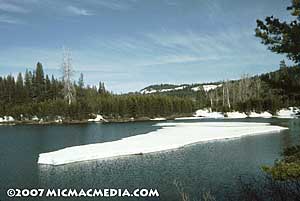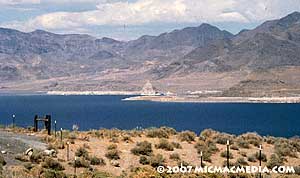 |
|
|
Follow Mark on Facebook for more stories |
||
|
Donner Party Winter: How big was it? For more than 160 years now, the common perception has been that the winter of 1847 (the year of the Donner Party) was one of exceptional snowfall. But was it? We have contemporary eyewitness accounts of snowdepth at various spots in the Sierra (many by people in unfamiliar locations and under severe stress), but the few scientific studies conducted evaluating precipitation that winter offer conflicting results.
One dendrochronology study concluded that lake levels of the Great Basin of Nevada and eastern Oregon were somewhat low during most of the 1840s and generally increased after 1850. Tree rings indicate that drought was more frequent for most areas in the Intermountain West during the 1840s, particularly in eastern Oregon and eastern Nevada. Scientists at the Laboratory of Tree-Ring Research, University of Arizona in Tucson, developed a tree-ring chronology of California and the Sierra in the 1980s. There were four types of trees used in this study, selected at a variety of sites in California and the west, including one on Donner Summit. The California sites were located within or close to the Sacramento Basin. These data were applied to the reconstruction of river flows, including the Sacramento, Feather, Yuba and American, which drain the northern Sierra Nevada. Low flow years in the region's river drainages included 1843-50 (Sacramento) and 1843-48 (American), which suggests below average precipitation during the winter of 1846-47. In fact, all of the four rivers indicated below normal water flow in 1847. As a result of this study, seasonal precipitation for the Sierra Nevada during the winter of 1847 is estimated at 80% to near normal.
For example: A Pacific storm may generate one inch of water during its passage. If the storm is cold, more snowfall will be measured than if it is warm, even though the same one-inch of precipitation will have fallen. Sierra snowstorms average about a 1:12 ratio, meaning that for every inch of water available a foot of snow will fall. A lower ratio than that makes for relatively wet snow that skiers often call "Sierra cement." However, if the storm is cold enough, that ratio can climb to 1:18, and sometimes greater, meaning that 18 inches or more snowfall will be measured. The Wasatch Mountains in Utah commonly get snowfalls in the 1:20 ratio and greater, thus earning their mountain resorts the bragging rights of great skiing in "champagne powder." Cold temperatures can also reduce the annual growth of tree rings. In January 1847, shallow ponds in San Francisco were covered with thin ice for a period of time. During the second week of March 1847, naval surgeon Dr. Marius Duvall was stationed aboard the American warship Portsmouth , anchored in Monterey Bay. His observations indicated an exceptionally cold storm raging over California. "The last few days the [weather] has been excessively cold and is disposed to continue so." He also wrote, "The hills near here [Monterey] are covered with snow, and last night some fell in town." Hail fell in San Francisco that week and high temperatures were only about 40 degrees. In a remarkable contradiction to the California tree ring chronologies, climate reconstructions of lake levels in Nevada, first published in 1941, indicate precipitation in the Pyramid and Winnemucca lake watersheds at 180% of average during 1847. Pyramid Lake is the terminus of the Truckee River and water levels in that lake represents precipitation amounts for both the Donner Lake and Alder Creek campsites that are located east of the Pacific Divide and are considered part of Great Basin hydrology. There are also plenty of contemporary accounts that corroborate the evidence for a wet winter that year.
John Craig was anxious to return to Utah in the spring of 1847, but was delayed for several weeks due to floodwaters in the Sacramento Valley. The waters finally receded enough for Craig to escape in early June; "On my return home I supplied myself with seven mules with packs and all things necessary and in company with seven others we started for home [Ogden, Utah], on June 2. On the fifth day we crossed the peak of the California mountains and had to travel about 35 miles over snow varying from 5 to 20 feet deep and rode over numerous mountain streams on arches of snow whilst we could hear the water roaring and dashing under our feet." It is possible, even likely considering the eye witness accounts, that cold temperatures and low snow levels during the winter of 1847 produced significant snowfall at Donner Lake and Alder Creek, as well as a hefty snowpack in the higher elevations. With low water content in the snowpack, however, tree ring growth representing that season may indicate a near normal water year. Regardless, snow six feet deep at Donner Lake by December 3 and much more in the higher mountains played a key role in trapping and isolating the 81 California-bound emigrants we call the Donner party. |
|||||||||||||||
|



